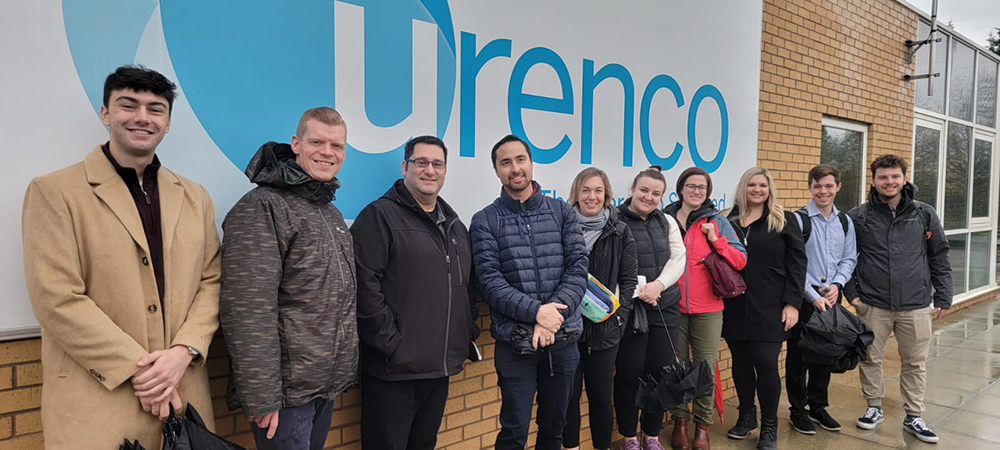The nuclear safeguards enterprise is international in scope and involves many different facilities in the nuclear fuel cycle, including but not limited to reactors, uranium enrichment facilities, fuel fabrication facilities, reprocessing facilities, and waste repositories. Moreover, the types of facilities may also differ from country to country. For this reason, it is valuable for safeguards professionals to have familiarity with a wide array of different facilities to understand how they operate and how the materials they handle are safeguarded.

The Center for Nuclear Security Science and Policy Initiatives (NSSPI) partners with Argonne National Laboratory (ANL) to conduct the International Nuclear Facilities Experience, known as the INFE, for students and young laboratory professionals working in the area of nuclear nonproliferation and safeguards. Sponsored by the Office of International Nuclear Safeguards in the Department of Energy’s National Nuclear Security Administration (NNSA), the INFE provides participants with a fuller understanding of facility operations, nuclear materials management, and applied material safeguards than they would normally have through their academic coursework. As they visit a series of facilities, practitioners and facility operators give presentations and discuss the practical application of safeguards and security measures. Participants can witness first-hand how nuclear safeguards work at various types of facilities, some not found within the US.
In November, NSSPI Director Dr. Sunil Chirayath and Dr. Claudio Gariazzo of ANL led this year’s INFE to the United Kingdom (UK). The group of participants included two NSSPI graduate students, graduate students from North Carolina State University, Pennsylvania State University, and the University of Michigan, along with young professionals from the NNSA and Argonne, Pacific Northwest, and Oak Ridge National Laboratories. In the UK, they followed the nuclear fuel cycle from enrichment to storage with technical visits to the URENCO-UK gas centrifuge enrichment plant, the Westinghouse Springfields fuel fabrication facility, and the Heysham nuclear power plant, and a briefing on the Sellafield nuclear waste processing and storage facility.

NSSPI Ph.D. student Sean Martinson remarked, “The INFE to the United Kingdom was an amazing opportunity. We saw nuclear safeguards in action, saw most of the nuclear fuel cycle, and learned from industry experts. There are things that cannot be simulated in a classroom that must be experienced.”
One aspect of this that Martinson pointed to was the scale of the facilities and the sizes of the areas established under safeguards for inventory purposes, also known as Material Balance Areas. “It was humbling to see quantities of material commercial facilities use,” he explained. In the classroom, he argued, “it is not easy to convey the scale of facilities and the sizes of material balance areas within them.”
The INFE also allowed the participants to have candid interactions with safeguards professionals. Jessica White-Horton, a research and development staff member in the International Safeguards group at Oak Ridge National Laboratory, lauded this aspect of the facilities visits. “The opportunity to not only go ‘behind the scenes’ but to interact with experts—specifically the newly-minted UK Office of Nuclear Regulation—is a once-in-a-lifetime opportunity for nonproliferation professionals,” she asserted. “The conversations had during the INFE will further shape our future work throughout our careers.”

University of Michigan graduate student Flynn Darby echoed White-Horton’s appreciation of the expert interactions throughout the INFE. “I was particularly impressed by the presentations from several safeguards’ representatives at each facility, their applicable knowledge to each material balance area and informative answers to our several questions asked during tours,” he said. “The INFE,” he added, “was a formative experience for me as a young and developing nuclear safeguards professional. Seeing most of the nuclear fuel cycle in person and interacting with professionals at each facility greatly improved my knowledge and mental framework around nuclear safeguards.”

Dr. Andrew Breshears, who works as a principal nuclear chemist at Argonne National Laboratory, describes the value of the INFE to young professionals in the nuclear nonproliferation and safeguards mission space. “I have already used much of the information I learned during the INFE to enrich my everyday job duties,” he acknowledged. “To say that the INFE was enlightening, useful, and timely for my career is an understatement.”